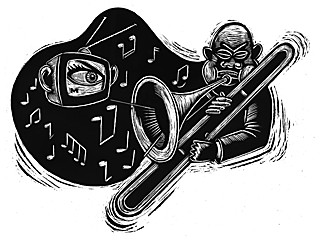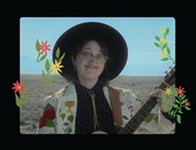Jazz's Generational Divide
Findings From the 28th Annual International Association of Jazz Educators Conference in NYC
By Jay Trachtenberg, Fri., Feb. 2, 2001

The small conference room was maybe a quarter full of well-dressed, gray-haired academic types, taking notes and listening studiously to a petite, schoolmarmish English woman presenting an analytical study of Django Reinhardt's Quintet of the Hot Club of France. Next door, meanwhile, blaring through the wall, the keening wail of a saxophone and amped-up guitar was being supplied by a handful of upstart high school students. Their boisterous squawk was hardly what these proper aficionados would consider jazz, but then they did succeed in all but drowning out the lecture adjacent to them.
This disorienting interface, much too early in the morning, was a brief interlude within the overall milieu of four full days of torrential activity at the recent 28th Annual International Association of Jazz Educators Conference in New York City. Beside illustrating the breadth of this enormous affair, however, it also crystallized a primary dilemma facing the jazz community at large: the cavernous generation gap between aging, lifelong fans raised on bebop and budding, MTV-era enthusiasts who have a much different jazz aesthetic -- if in fact they have one at all.
How does one bring a music whose acknowledged heyday was two or three generations ago to the youth of today and still retain some semblance of its integrity and rich history? That issue reared its head time and again throughout the week. The serendipity of having the conference coincide with PBS' airing of Ken Burns' Jazz documentary wasn't lost on its attendees either, and was of course debated at every turn.
The IAJE bills itself as "the world's largest jazz gathering," with upward of 8,000 educators, musicians, and industry representatives from 35 countries in attendance. Originally intended primarily for educators, the IAJE has attracted the full spectrum of the jazz community (deejays, journalists, record labels, sheet music publishers, instrument manufacturers) thanks in part to the recent demise of the annual Jazz Times convention. Like any other huge event of this scope, you plug into it at whatever level suits your interests.
You could scurry around doing nothing but attending academic workshops or listening to an endless array of high school jazz bands. Likewise, you could hobnob with industry insiders or attend topical panels flush with jazz luminaries. Even so, this is not the place to hear what's on jazz's cutting edge.
Mainstream jazz, much of it outstanding, is the order of the day. From huge big bands studded with name artists to all-star and unknown small groups to solo performers, it's all here and virtually all mainstream. This isn't necessarily bad, of course, just not as inclusive as it could be, especially if you're looking to attract younger listeners to the music.
Representing Austin's National Public Radio outlet KUT, I attended the daylong NPR Jazz Radio Symposium. At least this group has gotten past the point of arguing over whether Kenny G is a bona fide jazzman or the Antichrist and moved on to more substantive issues. It was apparent to all that while "real" jazz has virtually disappeared on commercial radio, its sole provenance has become NPR and other community-radio outlets whose income largely stems from listener contributions. This dependence, in turn, brings up the recurring dilemma faced by many stations, especially those programming jazz 24-7.
In a nutshell, how do you serve the more mainstream tastes of boomer-age listeners, whose pledges are presently keeping the station afloat, without totally alienating the younger listeners who will hopefully be your supporters in the future? Conversely, if you play too many edgier artists that appeal to younger ears (i.e., Medeski, Martin & Wood, Charlie Hunter), will you still draw enough older listeners to pay the bills? It's a delicate proposition, to be sure, but it was obvious at this conference that most jazz stations have opted for the safe, mainstream route.
In fact, some stations' formats are so rigid that they can't even take full advantage of opportunities like the Ken Burns opus. Newark flagship station WBGO, which covers the entire NYC area, is heavily promoting and even simulcasting Jazz, yet refusing to play Louis Armstrong, Duke Ellington, or any other pre-Sixties music from the series during its normal broadcast day. Go figure.
More than once, someone noted out loud, "We are our own worst enemy." To wit, after a heated discussion at a well-attended session on how to better attract younger listeners, it was painfully ironic to see the room empty by more than half for the very next session, "The MTV Generation of Jazz Radio."
Said twentysomething panelists were, not surprisingly, mostly turned off by the overall tone and presentation of jazz radio today. A generation raised on music videos, they're far more attuned to the way music is presented visually than their parents, and certainly more so than the generations who absorbed their music mainly through radio.
Some complained of jazz not being visual enough, although as an astute panelist noted, some of the most seductive and arresting visuals in any genre were captured in the classic photographs of Herman Leonard, Bill Gottlieb, and William Claxton. Because this generation is more culturally diverse than their elders, they're more attuned to the interweaving of different strains like world music and hip-hop into the presentation of jazz.
Another indication of the generational divide is the technology issue. You wouldn't know from this conference -- with its scant few panels pertaining to "Jazz On-Line" -- that the way we all acquire and listen to music is on the verge of fundamental change. One rather frustrated webcaster put it thusly: "We can't get ahead of the curve, because we don't know where the curve is going."
In light of all that's been written on the Burns documentary prior to the IAJE, the panel discussion on the program itself (featuring Burns' representatives) was lively to say the least. Jazz has been lambasted by critics from every front, from its "Great Man" historical viewpoint and over-reliance on Wynton Marsalis' reactionary perspectives to its criminal condensation of the last 40 years into the concluding two-hour episode this week.
Burns' appointed flak-catchers handled themselves well before a not particularly hostile audience, often regurgitating responses previously set forth by Burns himself. While I agree with many of my colleagues' objections, their caustic tirades have mostly fallen on deaf ears. For the 99.9% of viewers who are not among the rarefied cognoscenti, the program has been an exceptionally enlightening experience.
When was the last time Armstrong or Ellington garnered this much exposure on national television? And not the aged, hanky-toting, Cheshire-grinning Armstrong I remember from his appearances on Ed Sullivan in the Sixties, either; this is the regal, dazzling, youthful Armstrong, singing and blowing at the peak of his improvisational powers for all to admire.
How often are still-sensitive racial issues put before us in such an unabashed manner? Irrespective of the music, the photos and film clips of both the musicians and early-20th-century America form an amazing window on our past.
This history of jazz is intended for a mainstream audience, not a coterie of experts who already make their living writing about the music. If it piques some viewers' interest enough to go buy an Armstrong or Charlie Parker CD, or seek out jazz on the radio, what's wrong with that? The music can certainly stand to gain some new converts.
This was brought home to me my last night in town, standing in line on the Village Vanguard stairway while waiting to get into the last set of the evening. Next to me in line was a black couple in their 40s, obviously somewhat interested in jazz to even be there at 1am.
The gentleman started talking about Jazz, and they both noted how pleasantly surprised they were by the first episodes after having read the bad reviews. The woman was enthused at how much she was learning about the music's early history and the central role of African-Americans in its development. Was I to politely but matter-of-factly feed them my colleagues' argument about Burns' misguided vision, or how Marsalis' pompous ramblings are decidedly narrow-minded? I think not.
While I ended up not staying for that last set due to the late hour and an impending early flight, I did make three earlier gigs that evening. One was the most satisfying set of my entire trip: young saxophonist Chris Potter's quartet, with magnificent drummer Brian Blade in tow, turning in a sterling performance to a jam-packed house at the Knitting Factory.
The previous night four different groups, all of whom record for the feisty, independent Sharp Nine label, filled Smoke, an intimate club near Columbia University. The best of these were a Latin combo led by trumpeter Brian Lynch, and a quartet with vibraphonist Joe Locke and pianist David Hazeltine.
Still, the most memorable of the conference performances was a tribute to the late trombonist Al Grey, with Slide Hampton leading a group of 12 (count 'em) trombones and a rhythm section. All the city's major 'bone players were there, and wow, what a sound when they played in unison! Also noteworthy were sets by the fire-breathing All for One, a Jazz Messengers-influenced sextet nominally led by young saxman Eric Alexander, as well as a sublime yet high-flying interlude by the Maria Schneider Orchestra.
So after four full days and nights of seminars and live music, do I have a better sense of whither jazz? Will it disappear within a few short generations as its naysayers portend, or just become an historical curiosity to be showcased as museum art at institutions like Lincoln Center? Will the younger generation transform jazz with fresh ideas and impassioned visions, or simply ignore it, allowing the ravages of time and popular culture to cast it into the dustbin of musical history?
I'm not sure attending the IAJE could answer these questions, but at least it brings the faithful together for a few days to listen, schmooze, debate, and revel in the music we love. ![]()
Jay Trachtenberg is the host of Jazz, Etc. on KUT 90.5FM, Wednesdays, 8pm-midnight, and Jazz Junction on KGSR 107.1FM, Sundays, 11am-noon.







